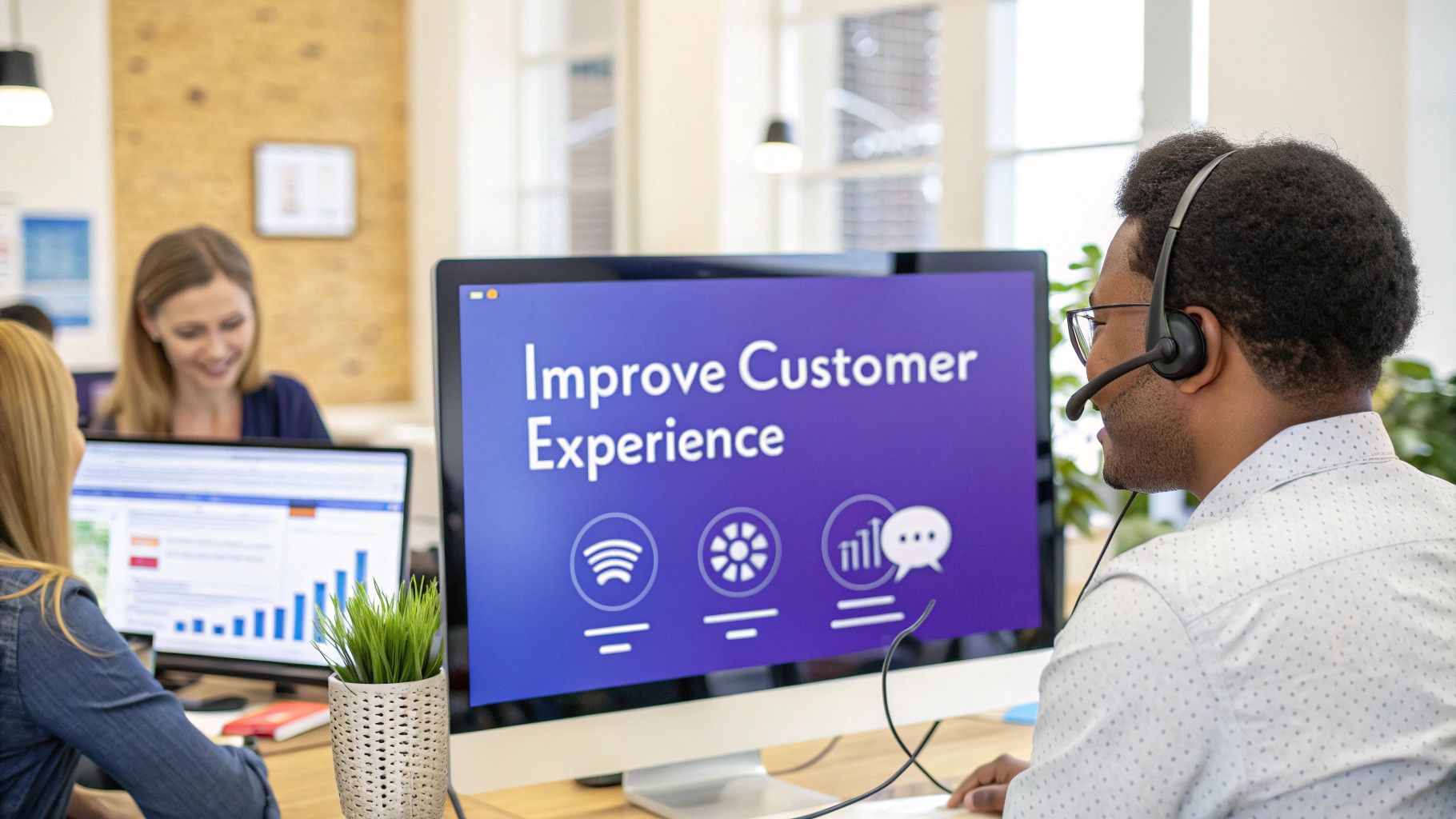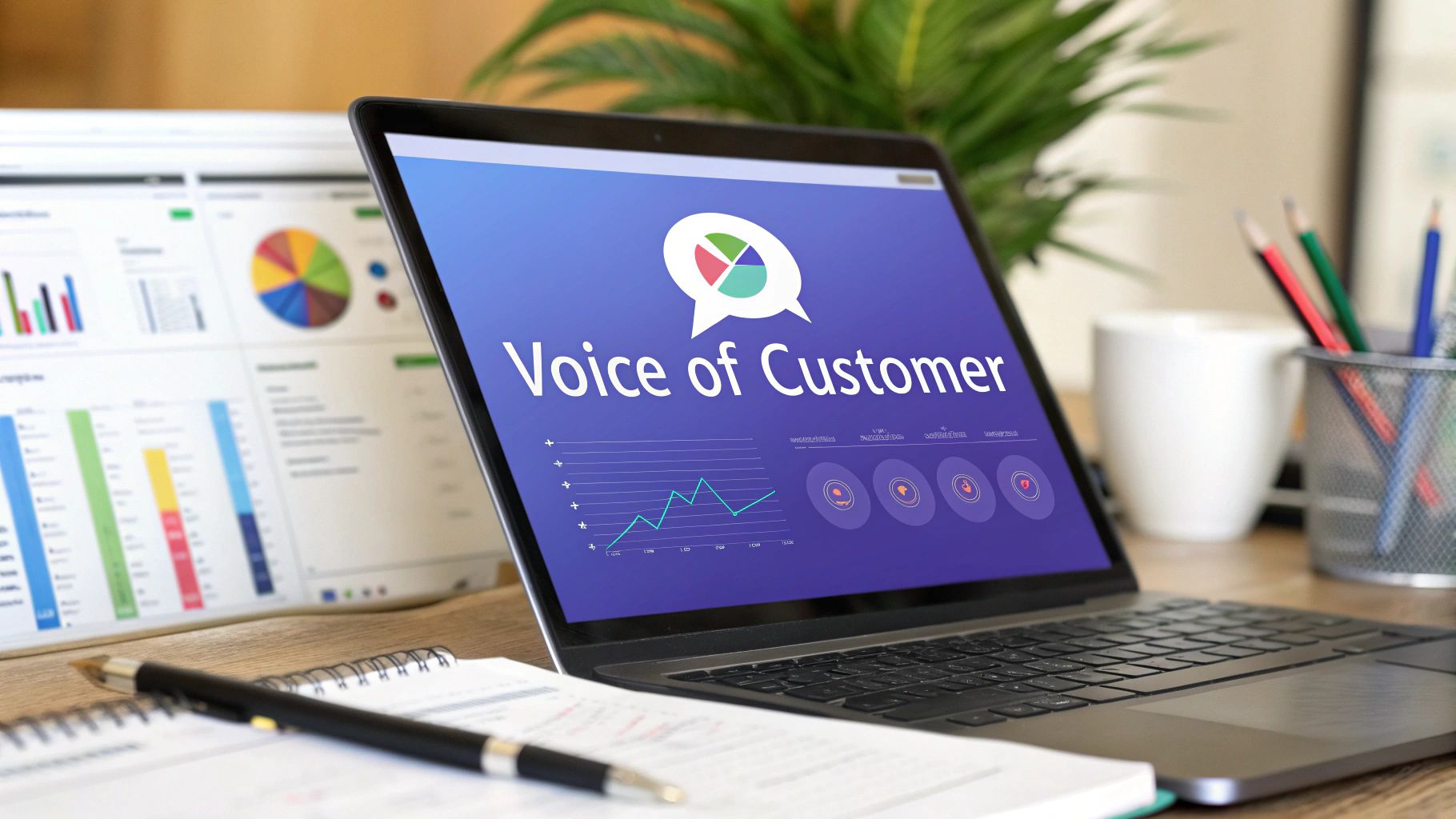how to improve customer experience: practical steps
how to improve customer experience: a practical guide to boost satisfaction and loyalty. Learn to map journeys, collect feedback, and tailor service.

To improve your customer experience, you first need a solid idea of why it’s become such a big deal for your business. Good customer experiences build loyalty, drive revenue, and create a powerful competitive advantage, turning happy customers into your best marketing channel.
Why a Great Customer Experience Matters More Than Ever
In the past, businesses could get by competing on product features or price alone. That game has completely changed. Customers today have endless options, and their expectations for service are sky-high. Just one frustrating interaction can be enough to send them straight to a competitor for good.
This shift means the quality of your customer experience (CX) is a massive factor in your company's success. It has become a core piece of your business strategy that touches every single stage of the customer journey. Every interaction matters, from the moment someone first lands on your website to when they receive their product.
The Business Impact of a Strong CX
A positive experience does more than just make customers happy. It hits your bottom line in some very real ways:
- Increased Customer Retention: Happy customers are loyal customers. When people feel valued, they’re far more likely to stick with your brand, even if a competitor dangles a slightly lower price in front of them.
- Higher Revenue and Growth: Satisfied customers tend to spend more over time. They're also the first ones in line to try your new products and services, opening up more avenues for growth.
- Stronger Brand Reputation: People talk, especially about their experiences. A great CX fuels positive word-of-mouth, which is still one of the most powerful and trusted forms of marketing out there.
The link between customer experience and business performance is undeniable. Companies that consistently deliver positive interactions build a loyal base of customers who not only stay but also become advocates for the brand. That's how you create a sustainable path for growth.
The Growing Demand for Personalization
Modern customers don't just want personalization; they expect you to know them. They’re looking for interactions that feel relevant to their specific needs and their history with your company. Those generic, one-size-fits-all approaches just don’t cut it anymore.
The numbers back this up. By 2025, an estimated 89% of businesses are expected to compete primarily on CX, blowing past traditional factors like product and price. We've also seen that companies excelling in personalization pull in 40% higher revenue compared to their competitors.
Let's break down what today's customers are really looking for.
Key Drivers of Modern Customer Experience
This table shows the core elements customers expect from businesses today, giving you a quick overview of what to focus on.
These expectations highlight a major shift: it's all about making the customer feel seen, heard, and valued at every turn.
This is exactly why measuring customer experience is so important. You have to gather feedback and dig into the data to find out what your customers are really thinking and feeling. By getting a clear picture of their pain points and preferences, you can make smarter decisions that lead to more meaningful and effective interactions. That's the foundation for building a service people love and a business that thrives.
Mapping Your Customer Journey to Find Opportunities
You can't fix what you can't see. To really improve your customer's experience, you first have to know what that experience actually feels like from their side. This means you need to get in their shoes and trace every step they take with your business.
We do this by creating a customer journey map. Think of it as a visual story of every single interaction someone has with your company, from the moment they first hear about you to the point where they become a loyal fan.
This map captures the entire relationship: that first Google search, how they felt navigating your website, the ease (or frustration) of the checkout process, and every email they receive afterward. Each one of these is a touchpoint, a moment that can either delight them or drive them away.
Identifying Key Customer Touchpoints
Every business is different, but customer journeys tend to follow a similar pattern. Your job is to pinpoint what's happening at each stage and, more importantly, how your customer is feeling.
- Awareness: How do people even find out you exist? Maybe it's a social media ad, a blog post that ranked well on Google, or a recommendation from a friend.
- Consideration: This is the evaluation phase. They might be comparing your prices, digging through customer reviews, or watching a demo video to see if you're the right fit.
- Purchase: How simple is it to give you their money? A clunky, confusing checkout is a classic conversion killer. So many sales are lost right here.
- Service: What happens when they run into a problem or have a question? This covers everything from your self-service help center to a one-on-one chat with a support agent.
- Loyalty: How do you convince them to stick around? This is all about the follow-up, like thoughtful emails, exclusive offers, and making them feel appreciated long after the sale is complete.
By looking at the journey from the customer's point of view, you can spot the hidden bumps in the road. An issue that seems minor internally, like a slow-loading page or a confusing policy, could be a major source of irritation for your audience.
The infographic below really drives home how meeting customer expectations and adding a personal touch directly impacts your bottom line.

It's a clear flow: when you meet rising customer expectations with interactions that feel made for them, your business grows. It's that simple.
Turning Insights Into Action
Once you've mapped out the journey, you can start digging in with some tough questions for each touchpoint. Where are people getting stuck? What questions pop up over and over again? This is where you'll find great opportunities for improvement.
For a much closer look at building one of these maps, check out our guide on customer experience mapping.
This process gives you a clear, actionable roadmap. You'll know exactly where to focus your energy to make the changes that matter most to your customers.
Gathering Customer Feedback You Can Actually Use

If you want to create an experience your customers love, you have to stop guessing what they want. It almost never works. You need to gather feedback directly from the source. But it’s how you ask, and what you do with the answers, that separates useless noise from game-changing insights.
Plenty of companies get this wrong. We’re seeing more and more brands struggle with customer experience. In the US, a staggering 25% of brands saw their customer experience scores drop in 2025, while only a tiny 7% actually got better. That gap usually comes from a massive disconnect between what a company thinks customers want and what they really need.
The real magic happens when you turn raw comments into something you can actually act on.
Where to Find Actionable Feedback
Good feedback collection is more than just sending out an annual survey. To get the full picture, you need to be listening everywhere, all the time.
Here are a few places I've found to be goldmines for honest feedback:
- Targeted Surveys: Forget those long, boring questionnaires. Think short, specific surveys dropped at just the right moment. A quick post-purchase survey can tell you everything about your checkout flow, while a survey right after a support chat is perfect for gauging agent performance.
- Organic Conversations: Your social media comments, live chat logs, and support calls are overflowing with raw, unfiltered feedback. These are real opinions from people telling you what’s working and what’s driving them crazy.
- Direct Interviews: Sometimes, the best way to get the full story is to just talk to your customers. If you really want to dig into their needs, check out these best practices for conducting effective user interviews that can drive real product success.
Here’s a pro tip: Don't just collect feedback; categorize it on the fly. When a complaint comes in, tag it with keywords like "billing issue" or "slow loading time." Before long, you’ll see patterns emerge that point you straight to the root of your biggest problems.
From Comments to Concrete Actions
Okay, so you've gathered all this feedback. Now the real work begins. Manually digging through hundreds of comments is a nightmare. It's slow, tedious, and you're bound to miss things. This is where AI-powered tools completely change the game.
A platform like Surva.ai can chew through massive volumes of text from surveys, reviews, and support tickets in minutes. It automatically pulls out recurring themes, analyzes sentiment, and flags trends, showing you exactly where you need to focus.
For example, the AI might reveal that 30% of your negative feedback mentions how confusing your website’s navigation menu is.
Boom. That’s a truly actionable insight. You now have a clear, data-backed reason to redesign that menu. We cover more strategies like this in our complete guide on how to collect feedback from clients. By using the right methods and tools, you can stop making assumptions and start making targeted changes that genuinely make your customer experience better.
Personalizing the Experience Without Being Intrusive
Today's customers don't just appreciate personalization, they expect it. They want to feel like you get them. This means interactions that are relevant and genuinely helpful, not just another blast from a generic marketing cannon. This is where personalization shines, but it's a tightrope walk. Get it right, and you build fierce loyalty. Get it wrong, and you just come off as creepy, which is a surefire way to lose a customer for good.
The secret to great personalization is using the data you already have to make your customer's life easier. It's about being helpful, not just showing off how much you know about them. Nailing this is a huge part of improving the customer experience because it proves you’re paying attention to the person, not just the sale.
Using Data for Genuinely Helpful Personalization
Think about it: your CRM is already a goldmine of insights. Purchase history, old support tickets, even how someone browses your website, these are all clues telling you what a customer might need next. Using this data thoughtfully is the first real step toward creating those "wow" moments that feel special.
Here’s what this looks like in the real world:
- Smarter Product Recommendations: Someone just bought a new camera from your online store. The next time they visit, it makes perfect sense to show them compatible lenses, tripods, or camera bags. You're anticipating their next move and saving them a search.
- More Relevant Support Chats: When a customer reaches out for help, your agent should instantly see their entire history. Knowing this is the third time they’ve asked about a specific feature lets the agent skip the basics and offer a much better, more informed solution. No more starting from scratch.
- Segmented Email Campaigns: Please, stop sending the same email to your entire list. If a group of customers has been eyeing a particular category of products, send them updates or offers related specifically to that. Suddenly, your email feels less like spam and more like a heads-up from a friend.
The real goal here is to make every single customer feel seen and valued. Good personalization should never feel like surveillance; it should feel like top-notch service. When you use what you know about a customer to save them time or point them to exactly what they need, you build trust.
Striking the Right Balance
So, where’s the line between being helpful and being intrusive? It really boils down to your intent and the relevance of your actions. Are you using their data to solve a problem for them, or are you just trying to squeeze out another sale? Trust me, customers can tell the difference.
Using a customer's first name in an email is table stakes at this point. It’s a nice touch, but it’s not true personalization.
Real personalization goes deeper. It’s about remembering a customer’s size preference so they don’t have to apply the same filters every single time they shop. It's about offering a small discount on an item they’ve clicked on three times in the last week. These are the small, thoughtful gestures that show you’re not just tracking them, you’re actively trying to create a smoother, more convenient journey. That’s how you make customers feel understood, and that's the bedrock of any lasting relationship.
Empowering Your Team to Deliver Exceptional Service

You can have the best tech stack in the world, but your customer experience ultimately comes down to your people. They are the human face of your brand, and their ability to solve problems with confidence and empathy is what really sets your service apart.
Simply handing your team a rigid script and a long list of rules is a recipe for disaster. This old-school approach leads to frustrated agents and even more frustrated customers. The real path to a better customer experience is building a team that feels trusted, supported, and capable of making smart decisions on the fly.
Give Your Team the Right Tools
You can't expect exceptional service from a team that's fighting with clunky, outdated software. Your employees need tools that make their jobs easier, not harder.
A well-organized internal knowledge base is a perfect example. When an agent can find the right answer to a customer's question in seconds, everyone wins. The customer gets a fast resolution, and the employee feels competent and efficient. This one change can have a massive impact on both satisfaction and morale.
Build a Culture of Ownership
A truly customer-focused culture is built on a foundation of trust. It’s about giving your employees the freedom to do what's right for the customer, rather than forcing them to escalate every minor issue.
When team members feel they have the authority to solve problems, they take genuine ownership of the outcome.
This shift in mindset creates a powerful, positive cycle:
- Faster problem-solving: Agents can resolve issues directly, which cuts down on wait times and customer friction.
- Higher employee engagement: People who feel trusted and valued in their roles are more motivated and far less likely to burn out.
- More authentic interactions: Conversations feel more human and less robotic, which is key to building stronger customer relationships.
The stakes for getting this right are incredibly high. Over half of customers report they will switch to a competitor after just one single unsatisfactory experience. This statistic shows the need to balance efficiency with genuine human connection to deliver consistently great service.
Train for Empathy, Not Just Process
Of course, your team needs to know your products and policies inside and out. But training shouldn't stop there. The best customer service teams are trained in soft skills like active listening, clear communication, and, most importantly, empathy.
Teaching agents to truly hear a customer's frustration and respond with genuine care can turn a negative situation into a moment of loyalty-building. This requires ongoing coaching and constructive feedback.
To really build this kind of continuous improvement, you might find value in resources like an ultimate playbook for giving feedback that motivates and corrects, which can help make sure your team is always growing.
Ultimately, when you invest in your team's skills and well-being, they’ll pass that investment directly on to your customers.
Questions We Hear All the Time About Improving CX
We’ve walked through a lot of ground on how to dial in your customer experience. But theory is one thing, and putting it into practice is another. You probably still have a few questions buzzing around.
Let's tackle some of the most common ones we get asked. Here are some straightforward answers to get you moving.
Where Should a Small Business Even Start with Improving Customer Experience?
For a small business, the best first step is also the simplest one: talk to your customers. Seriously. You don't need a massive budget or a complicated piece of software to get going. The most valuable insights almost always come from a good old-fashioned conversation.
Pick up the phone. Send a personal email. Heck, even a quick three-question survey can work wonders. Ask them what they love about what you do and what one thing you could change to make their life a little easier.
This direct feedback is gold because it gives you a clear, manageable starting point without needing a huge investment. You'll be amazed at what you can learn just by asking.
How Can I Actually Measure the ROI of CX Improvements?
Measuring the return on investment (ROI) for your CX efforts isn't as fuzzy as it sounds. It’s all about tracking the right numbers before and after you make a change. Don't try to track everything under the sun, just focus on a few key metrics that are tied directly to your bottom line.
Here’s what you should be watching:
- Customer Retention Rate: It's simple, happy customers stick around longer. Keep an eye on this number to see if it ticks up after you roll out your changes.
- Average Order Value (AOV): When customers feel good about their experience, they tend to spend more. An increase in AOV is a fantastic sign that you're on the right track.
- Net Promoter Score (NPS) or Customer Satisfaction (CSAT): These are your direct lines into customer sentiment. A jump in these scores almost always leads to better loyalty and more word-of-mouth marketing.
- Customer Support Costs: A better, more intuitive experience naturally leads to fewer support tickets. That’s a direct saving for your business.
By keeping tabs on these metrics, you can draw a straight line from the effort you're putting into the customer experience to the real, tangible growth of your business.
How Do AI Tools Like Surva.ai Fit into All of This?
This is where things get really interesting. AI-powered tools are a total game-changer for customer experience because they let you understand and act on feedback at a scale that’s just not possible for a human team. They handle the heavy lifting of data analysis, which frees you up to deliver those personalized interactions that matter.
Think about it: a tool like Surva.ai can sift through thousands of customer comments from surveys, reviews, and support tickets in just a few minutes. It can instantly spot common themes, figure out the sentiment behind the words, and flag new issues that your team might otherwise miss.
This gives you a clear, unbiased picture of what your customers are really saying. With that knowledge in hand, you can quickly zero in on the areas that will make the biggest impact.
Ready to turn your customer feedback into your biggest growth driver? Surva.ai gives you the tools to listen at scale, understand what your users truly want, and take action to build a better experience. Start your journey with Surva.ai today.


